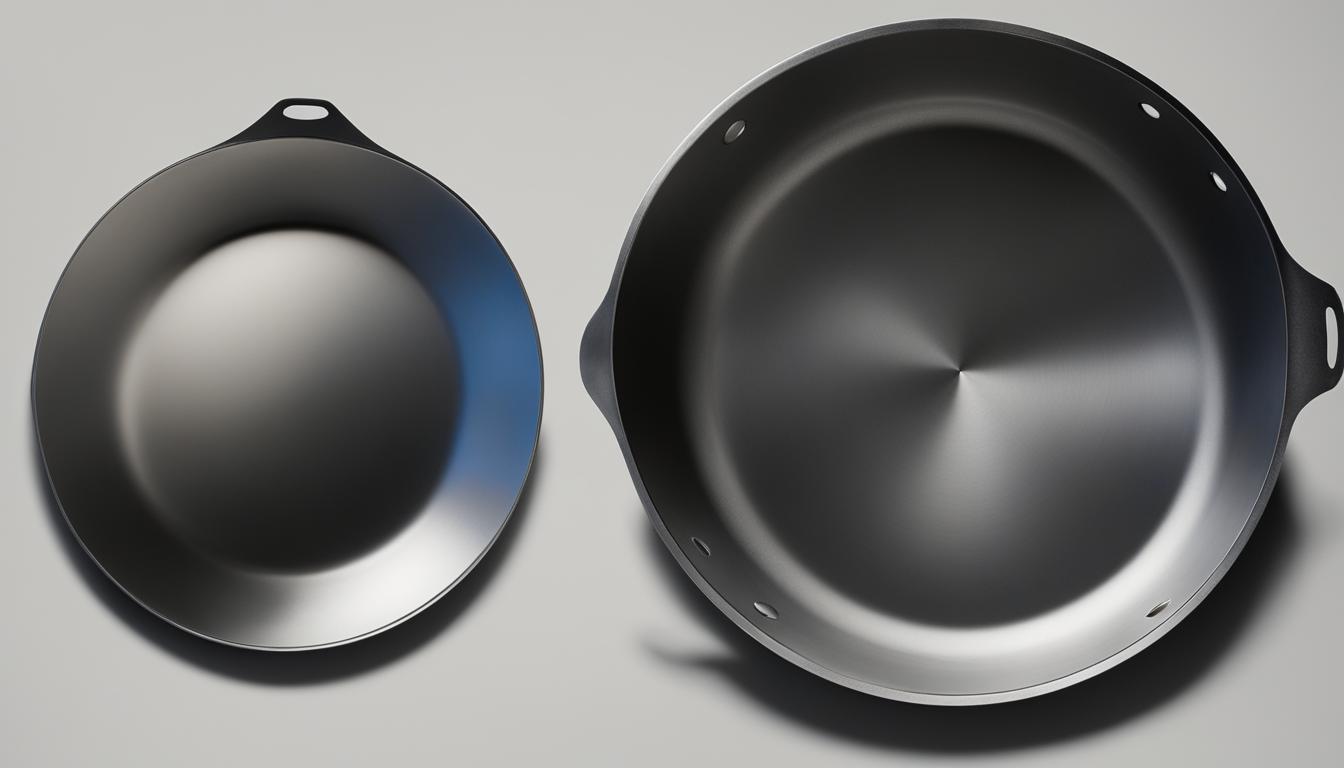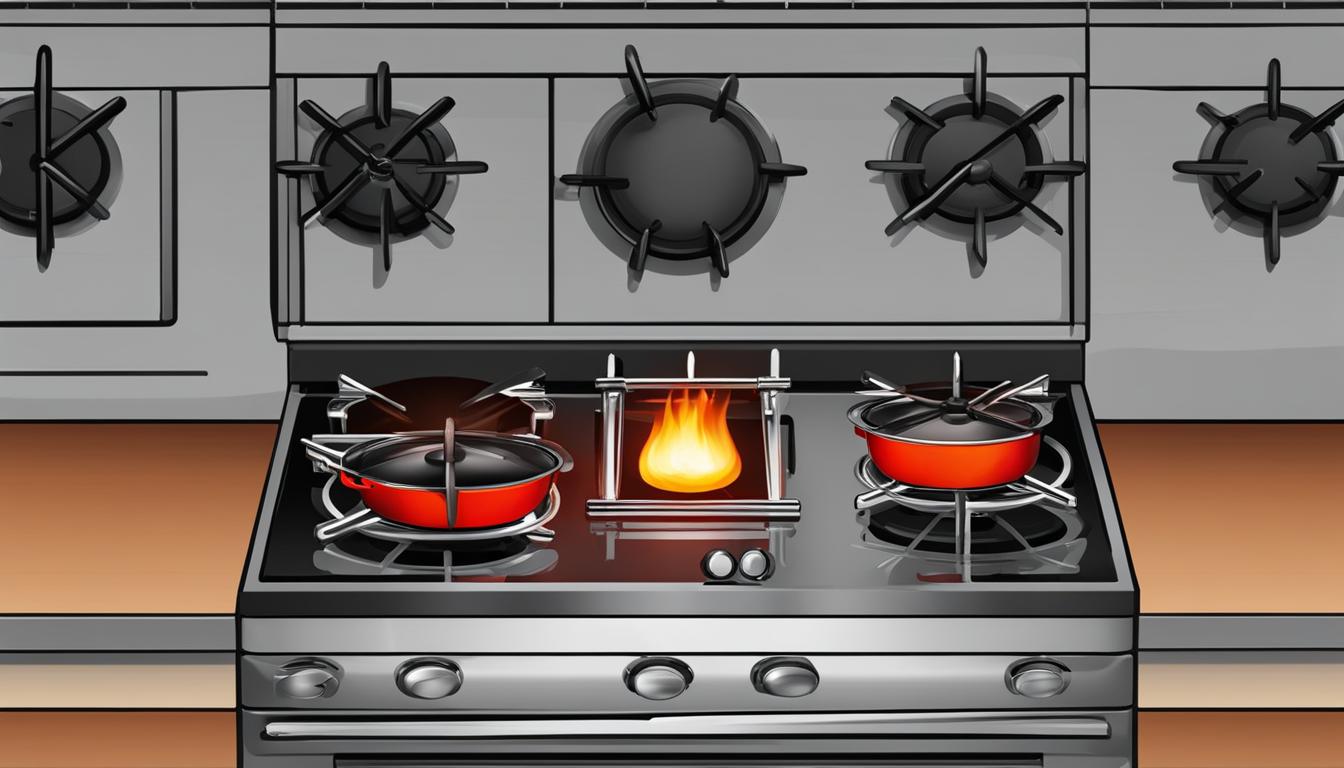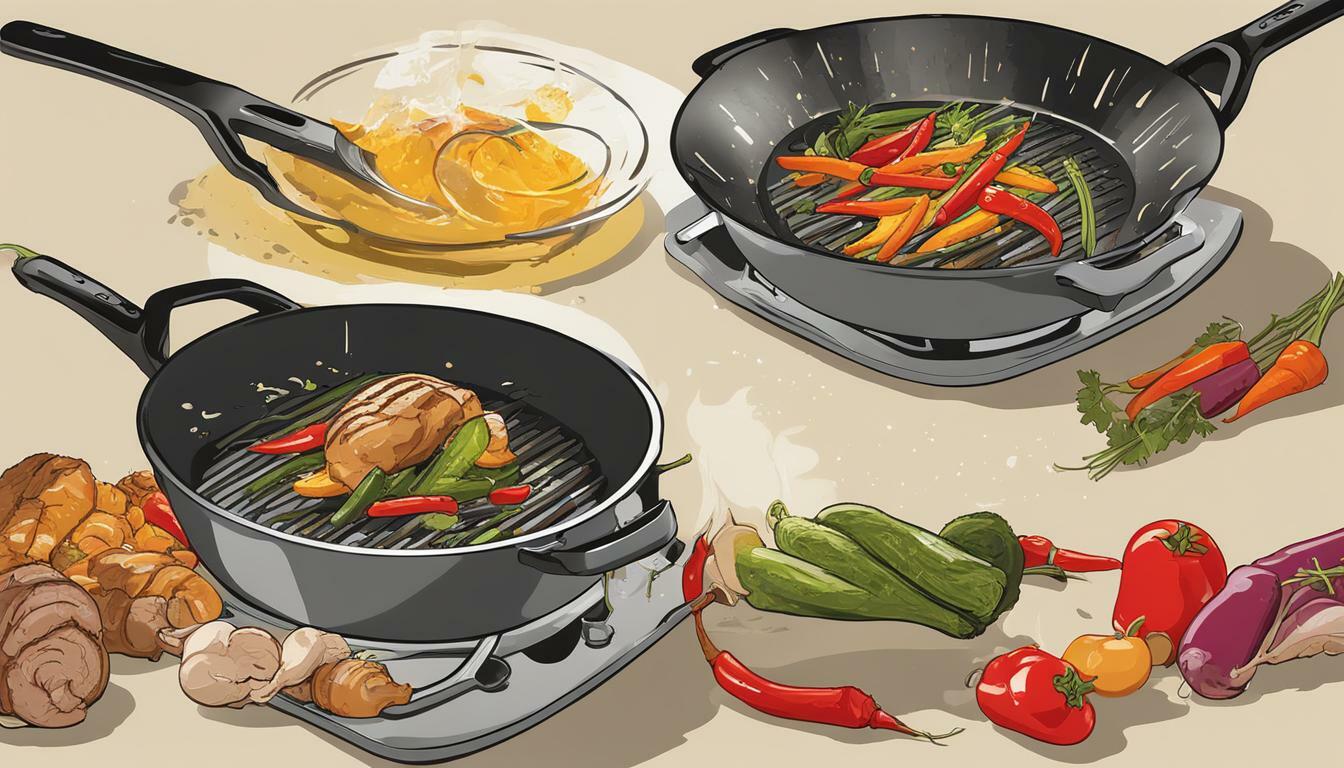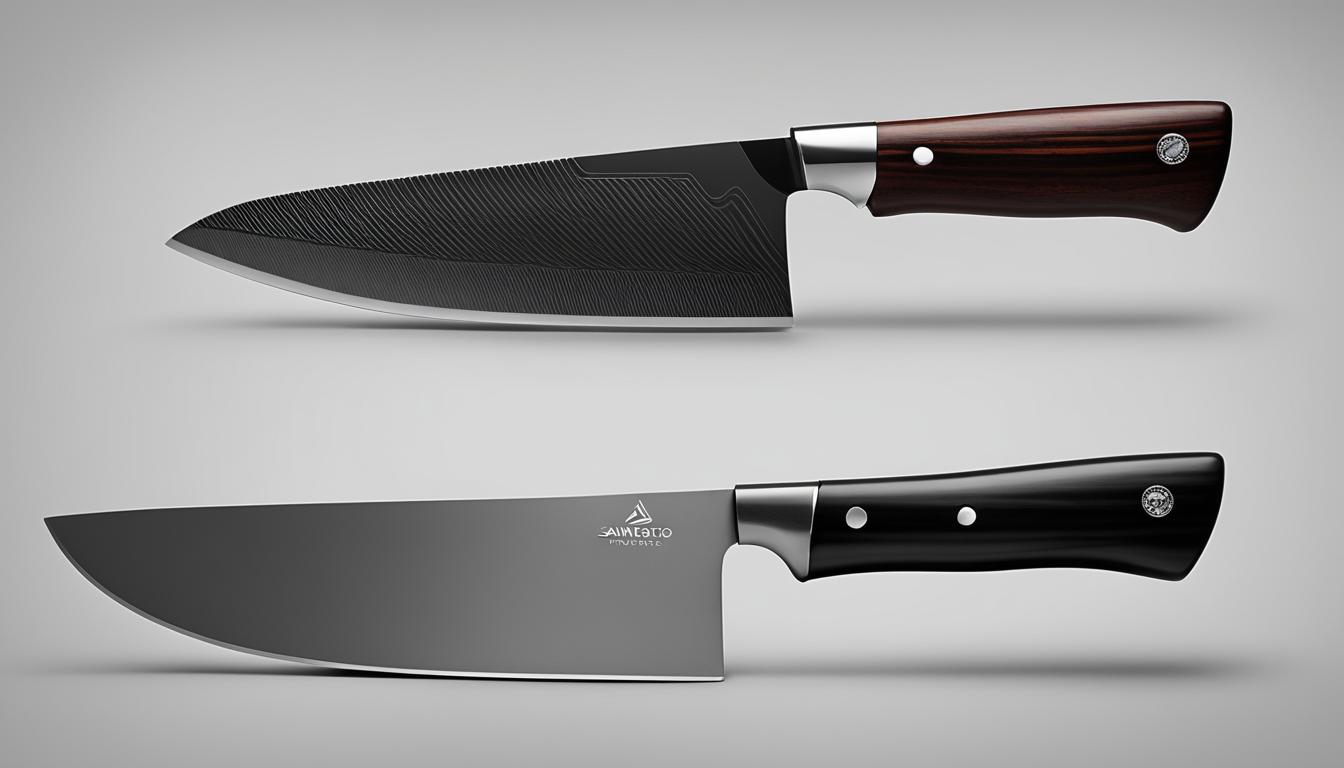When it comes to cooking, having the right tools can make all the difference. Two essential utensils in any kitchen are the wok and the skillet, also commonly known as a frying pan. Although they may seem similar at first glance, there are distinct differences between these two cookware options that can greatly impact your cooking experience.
A wok and a skillet are both made from carbon steel, offering similar heat retention and seasoning properties. However, the main difference lies in their shapes and designs. A wok features a rounded bottom and sloped walls, allowing liquids to concentrate in the center and heat to be trapped effectively. On the other hand, a skillet has a flat bottom and slightly sloped walls, providing even distribution of oil and heat.
The unique design of a wok makes it ideal for stir-frying and quick cooking, while a skillet is better suited for fragile meats and foods that require longer cooking times. Understanding these differences can help you choose the right cookware for your culinary needs.
Key Takeaways:
- A wok and a skillet have similar heat retention and seasoning properties due to their carbon steel construction.
- A wok’s rounded bottom and sloped walls make it perfect for stir-frying and quick cooking.
- A skillet’s flat bottom and slightly sloped walls provide even distribution of oil and heat, making it suitable for delicate foods and longer cooking times.
- Choosing between a wok and a skillet depends on your cooking preferences and the types of dishes you frequently prepare.
- Having both a wok and a skillet in your kitchen allows for more versatility and creativity in your cooking endeavors.
What Is a Wok?
A wok is a traditional Chinese cooking vessel that is designed for stir-frying. It has a rounded bottom and high, sloping walls that help retain heat and allow for quick and even cooking. The wok is made from Blue Carbon Steel, a lightweight and durable metal that provides excellent heat retention. It has a separate metal handle that stays cool for longer periods compared to cast iron woks.
Wok Features
A wok combines several features that make it unique and versatile for various cooking techniques:
- Shape: The rounded shape of a wok allows for excellent heat distribution and concentration in the center, making it ideal for stir-frying.
- Sloping Walls: The high, sloping walls of a wok enable easy tossing and stirring of ingredients without spilling over the sides.
- Heat Retention: Blue Carbon Steel, the material used in making a wok, has excellent heat retention properties, allowing for quick and efficient cooking.
- Metal Handle: The wok features a separate metal handle that stays cool for longer, ensuring a comfortable grip while cooking.
The combination of these features makes the wok a versatile and indispensable tool in the kitchen, perfect for creating flavorful stir-fries, deep-frying, and even steaming with the use of a bamboo steamer basket.
| Wok Construction | Blue Carbon Steel |
|---|---|
| Material | Lightweight and durable metal |
| Shape | Rounded bottom and high, sloping walls |
| Handle | Metal handle that stays cool |
What Is a Wok Used For?
A wok is a versatile cooking vessel that has been used in Chinese cuisine for centuries. Its unique design and shape make it ideal for various cooking techniques.
Stir-frying
Stir-frying is the most common and popular cooking technique used with a wok. The high, sloped walls of the wok allow for easy tossing and stirring of ingredients, ensuring even heat distribution. This technique is perfect for quickly cooking vegetables, meats, and seafood, creating delicious and flavorful dishes.
Wok hei
The signature smoky flavor, known as “wok hei,” is achieved by cooking ingredients at high heat in a wok. The intense heat caramelizes the sugars in the food, resulting in a rich, smoky taste that adds depth to the dish. This unique flavor is difficult to replicate using other cookware.
Deep frying
While often associated with stir-frying, a wok can also be used for deep frying. The rounded shape allows for a smaller amount of oil to be used compared to traditional fryers, making it a healthier option. The high sides of the wok prevent oil splatter and ensure even cooking of the food.
Steaming
A wok can be transformed into a steamer by adding a bamboo steamer basket. The large size and shape of the wok accommodate the basket, allowing you to steam dumplings, vegetables, and even fish. The sloped walls enable steam to circulate evenly, resulting in perfectly steamed dishes.
Overall, a wok is a versatile tool in the kitchen, allowing you to experiment with different cooking techniques and create delicious meals with authentic flavors.
Carbon Steel Wok Advantages
When it comes to cooking, carbon steel woks offer several advantages that make them a popular choice for both professional chefs and home cooks. Let’s explore some of the key benefits of using a carbon steel wok:
- Heat retention: Carbon steel woks excel at retaining heat, allowing for quick and efficient cooking. The material heats up rapidly and distributes heat evenly throughout the entire surface, ensuring that your ingredients are cooked to perfection.
- Quick cooking: Thanks to its excellent heat conductivity, a carbon steel wok allows for fast cooking times. The high, sloped walls of the wok help concentrate heat, making it ideal for stir-frying and other high-heat cooking techniques.
- Non-stick surface: Once properly seasoned, a carbon steel wok develops a natural non-stick surface that makes cooking and cleaning a breeze. This means you can use less oil while still preventing your food from sticking.
- Lightweight: Compared to other cookware materials like cast iron, carbon steel woks are relatively lightweight, making them easy to maneuver and handle in the kitchen. This is particularly useful when stir-frying or tossing ingredients.
- Professional-grade heat resistance: Carbon steel woks are built to withstand high temperatures commonly used in professional kitchens. This makes them suitable for use on various stovetops, including gas, electric, and induction.
- Healthier cooking: The non-stick surface of a carbon steel wok means you can cook with less oil, reducing the overall fat content of your dishes. Additionally, the fast cooking times help retain the natural flavors and nutrients of your ingredients.
With these advantages, it’s no wonder that carbon steel woks are a popular choice among cooking enthusiasts. The heat retention, quick cooking, non-stick surface, lightweight design, professional-grade heat resistance, and healthier cooking properties make them a versatile and valuable tool in the kitchen.
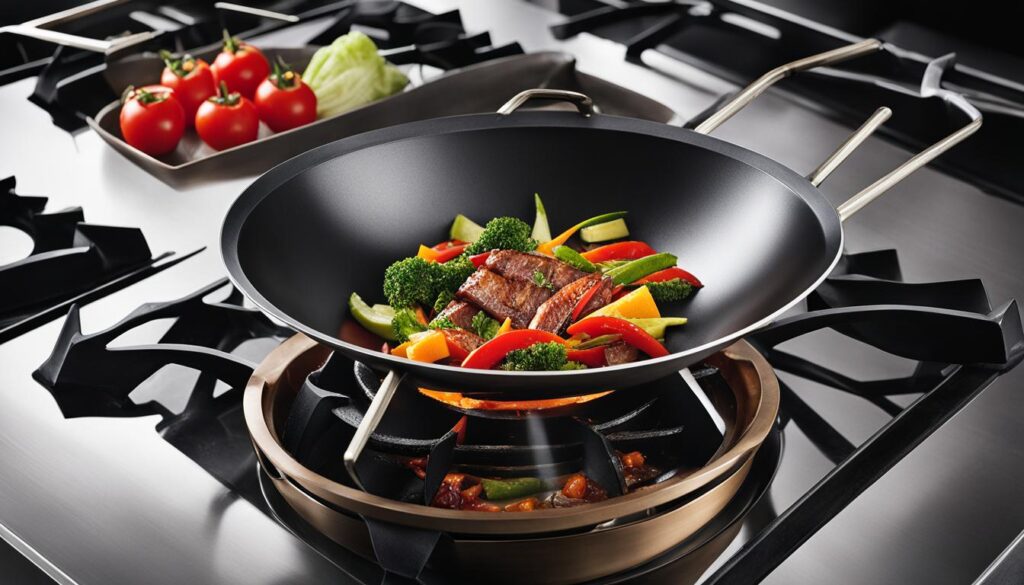
Carbon Steel Wok Considerations
When using a carbon steel wok, there are a few important considerations to keep in mind. The first is the high cooking temperature required for effective stir-frying. It’s essential to monitor the heat carefully to prevent food from burning and ensure even cooking.
Another consideration is rust prevention. Carbon steel woks are prone to rust if not properly cared for. After each use, it’s important to thoroughly dry the wok to prevent moisture from causing corrosion. Applying a thin layer of oil can also help protect the wok from rust.
Seasoning is a crucial step in maintaining a carbon steel wok. Before the first use, the wok needs to be seasoned to create a natural non-stick surface. Seasoning involves coating the wok with oil and heating it to form a protective layer. It should be noted that seasoning can wear off over time, so regular maintenance is necessary to keep the wok in optimal condition.
Lastly, it’s important to be mindful of cooking acidic foods in a carbon steel wok. Acidic ingredients can strip away the seasoning, affecting the wok’s non-stick properties. However, if the seasoning does get damaged, it can be re-seasoned to restore its functionality.
| Consideration | Tips |
|---|---|
| High cooking temperature | Monitor heat carefully to prevent burning |
| Rust prevention | Dry thoroughly after use and apply a thin layer of oil |
| Seasoning | Season before first use and maintain regularly |
| Acidic foods | Be cautious as they can strip away the seasoning |
What Is a Frying Pan?
A frying pan, also known as a skillet, is a versatile cooking tool that is commonly found in kitchens around the world. It is designed with a flat-bottomed surface and slightly sloping or flared-out sides, which allows for various cooking techniques such as searing, sautéing, and shallow frying. Frying pans can be made from different materials, including carbon steel, stainless steel, and cast iron. In this section, we will explore the definition, features, construction, and advantages of a carbon steel frying pan.
Definition and Features
A frying pan, or skillet, is a shallow, round cooking pan with a long handle. It is usually made from metal and is commonly used for cooking on stovetops. Frying pans typically have a flat bottom, which provides a stable cooking surface, and slightly sloping or flared-out sides, which allow for easy flipping and tossing of ingredients during cooking.
When it comes to features, a carbon steel frying pan stands out. Carbon steel is known for its excellent heat retention and distribution properties, making it ideal for searing and browning foods evenly. It also develops a natural non-stick surface when properly seasoned, making it easier to cook with and clean. Additionally, carbon steel is lightweight and heats up quickly, making it a popular choice among professional chefs and home cooks alike.
Construction and Types
Carbon steel frying pans are typically constructed using a single piece of metal, which provides durability and even heat distribution. The pan is made by stamping, pressing, or spinning the metal into shape, resulting in a seamless cooking surface. Carbon steel frying pans can come in various sizes and depths to accommodate different cooking needs.
There are also different types of carbon steel frying pans available, such as those with a solid handle or a removable handle. Frying pans with a solid handle are often preferred for their sturdiness and durability, while pans with a removable handle offer the convenience of easy storage and cleaning.
| Type | Description |
|---|---|
| Solid Handle | Sturdy and durable; no detachable parts |
| Removable Handle | Offers convenience for storage and cleaning |
Overall, a carbon steel frying pan is a versatile and practical tool for any kitchen. Its excellent heat retention, non-stick surface, and lightweight construction make it a favorite among chefs and home cooks alike. Whether you’re searing a steak, sautéing vegetables, or frying eggs, a carbon steel frying pan is sure to deliver exceptional results.
What Is a Frying Pan Used For?
Frying pans, also known as skillets, are versatile kitchen tools that can be used for a wide range of cooking techniques. Whether you’re searing meats, cooking delicate foods, or simply looking for an easy cleanup, a frying pan is an essential addition to any kitchen.
Frying Pan Cooking Techniques
One of the main uses of a frying pan is for searing. The flat bottom and even heat distribution make it perfect for achieving a nice crust on meats and other ingredients. The frying pan is also ideal for cooking delicate foods that may break apart in a wok, such as fish or eggs. Its low, sloping sides allow for easy flipping and stirring.
Easy Cleanup and Versatile on Different Stovetops
In addition to its cooking versatility, the frying pan offers the advantage of easy cleanup. Many frying pans come with a non-stick coating, preventing food from sticking and making it easier to clean after use. Furthermore, frying pans are compatible with various stovetop types, including gas, electric, and induction. This makes it a convenient option for any kitchen setup.
| Frying Pan Uses | Advantages |
|---|---|
| Searing | Even heat distribution for a nice crust on meats and ingredients |
| Cooking delicate foods | Low, sloping sides allow for easy flipping and stirring |
| Easy cleanup | Non-stick coating prevents food from sticking |
| Versatile on different stovetops | Compatible with gas, electric, and induction stovetops |
As shown in the table above, a frying pan offers several advantages for different cooking needs. From searing to cooking delicate foods and providing easy cleanup, it is a versatile and essential tool in the kitchen.
Conclusion
After considering the unique features and benefits of both a wok and a skillet, it is clear that the choice ultimately comes down to your cooking preferences and needs. A wok is the perfect tool for stir-frying and quick cooking, thanks to its rounded bottom and sloped walls that allow for concentrated heat and easy tossing of ingredients. On the other hand, a skillet excels at delicate foods and longer cooking times, with its flat bottom and even heat distribution.
Both the wok and the skillet have their advantages, making them valuable additions to any kitchen. By having both in your cooking arsenal, you can enjoy the versatility and creativity they offer. Whether you’re searing meats, stir-frying vegetables, or sautéing delicate foods, having a wok and a skillet allows you to explore a wide range of culinary possibilities.
Consider your cooking preferences and the types of dishes you enjoy making. If you tend to gravitate towards quick and vibrant stir-fries, a wok would be a fantastic choice. On the other hand, if you enjoy cooking delicate proteins or simmering sauces for longer periods, a skillet may be the better option. It’s worth noting that both the wok and the skillet can be used for various cooking techniques, so don’t be afraid to experiment and discover new flavors.
FAQ
What makes a wok different from a skillet?
The main difference lies in their shapes. A wok has a rounded bottom and sloped walls, while a skillet has a flat bottom and slightly sloped walls.
What is a wok?
A wok is a traditional Chinese cooking vessel designed for stir-frying. It has a rounded bottom and high, sloping walls.
What is a wok used for?
A wok is primarily used for stir-frying, but it can also be used for deep frying, steaming, and more.
What are the advantages of a carbon steel wok?
Carbon steel woks have advantages such as excellent heat retention, a non-stick surface, lightweight, and professional-grade heat resistance.
What should I consider when using a carbon steel wok?
Considerations include high cooking temperature, proper drying and storage to prevent rusting, seasoning before use, and avoiding cooking highly acidic foods.
What is a frying pan?
A frying pan, also known as a skillet, is a flat-bottomed pan with slightly sloping or flared out sides.
What is a frying pan used for?
A frying pan is versatile and can be used for searing, cooking delicate foods, and it offers easy cleanup. It’s also suitable for various stovetops.
Which should I choose between a wok and a skillet?
The choice depends on your cooking preferences and needs. Both have their advantages and can be valuable additions to your kitchen.
 Skip to main content
Skip to main content